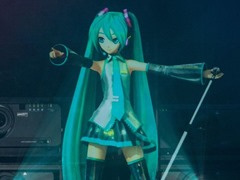 Would it surprise you to know that tens or hundreds of thousands of fans worldwide go to concerts by and participate in a fandom phenomenon around a text-to-speech program?
Would it surprise you to know that tens or hundreds of thousands of fans worldwide go to concerts by and participate in a fandom phenomenon around a text-to-speech program?
Meet Hatsune Miku, a “vocaloid” created by synthesizer company Yamaha. A “holographic” character from Japan, she sells out concerts where she “appears” as a motion-captured CGI animation, accompanied by a live band, to sing songs that her fans created on the Internet. Engadget has a lengthy article going into the background of vocaloid fandom, discussing the way her music is effectively crowdsourced by fans all over the Internet who create it using the specialized speech-synthesizer software she’s based on.
You can buy the software direct from Yamaha’s Vocaloid web store, in fact. The current version costs $108.
Hatsune Miku has appeared on the David Letterman show (it’s worth watching the video just to see Letterman’s expression of total bewilderment, which he doesn’t make any attempt to hide). She’s opened for Lady Gaga, and played in packed concerts all over the world—and she’s returning for six shows in the USA this year. The company behind Miku basically mines the best fan-created works to have the character sing “live” in concert, not unlike the way some traditional publishers sign self-published writers to contracts after they prove popular. But to me the most interesting thing is the way the star’s become a global singing sensation.
You don’t see anyone flocking to concerts or writing new works for the voice that reads your e-books in Amazon’s Kindle software. But then, you don’t see companies putting the kind of effort into e-book readers that they do into speech synthesizers meant to make music. After all, there’s a lot more money in music.
It does offer hope that, perhaps in a few years, other speech-synthesis applications such as text-to-speech for screen reading could take advantage of the technology Yamaha has developed. Still, given that the purpose is so different, it seems hard to see whether any of the technology that makes Hatsune Miku and her vocaloid sisters sing so well could ever be adapted to e-book reading software.
But you’d think they could at least make something that would sound a little less artificial. Hatsune Miku hardly sounds artificial at all—but that could simply be because it’s singing, rather than reading in a flat pitch. Regional accents tend to disappear when singing, too.

































